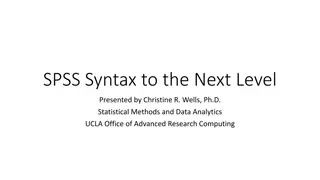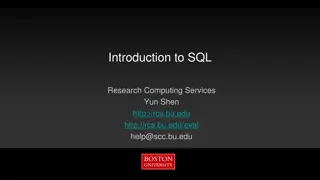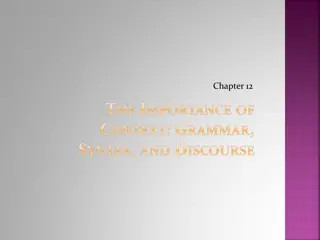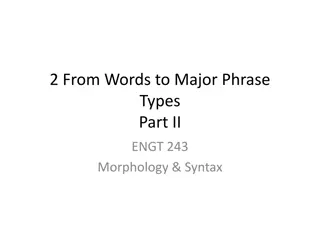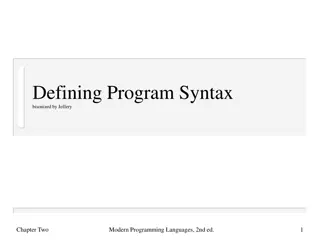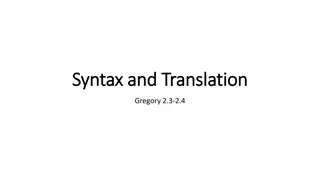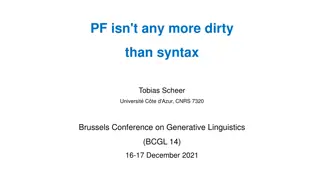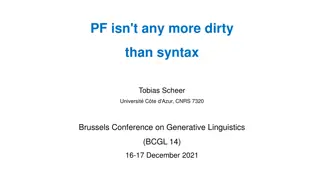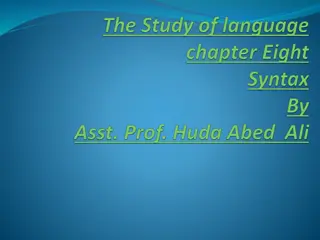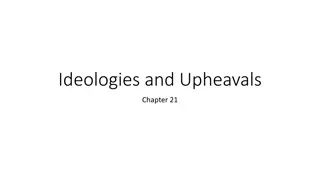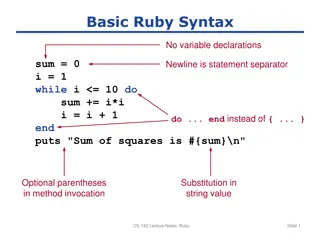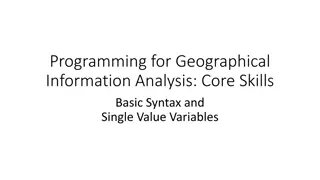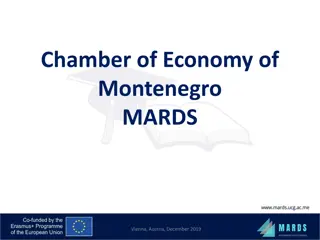
Sardinian Morphosyntax Workshop Insights
Discover the dialectal variations, nominal system, determiners, and clitic pronouns in Sardinian morphosyntax with a focus on regional differences, gender markings, and grammatical structures.
Download Presentation

Please find below an Image/Link to download the presentation.
The content on the website is provided AS IS for your information and personal use only. It may not be sold, licensed, or shared on other websites without obtaining consent from the author. If you encounter any issues during the download, it is possible that the publisher has removed the file from their server.
You are allowed to download the files provided on this website for personal or commercial use, subject to the condition that they are used lawfully. All files are the property of their respective owners.
The content on the website is provided AS IS for your information and personal use only. It may not be sold, licensed, or shared on other websites without obtaining consent from the author.
E N D
Presentation Transcript
Workshop on Sardinian Morphosyntax Mike Jones University of Essex
Dialectal variation There is significant regional and local variation in phonetics/phonology, lexis and morphology, though structural syntax is relatively homogeneous. The main dialectal division is between the South (Campidanese) and North, which is subdivided into two areas: Nuorese in the East and Logudorese in the West. My own research is based mainly on the Northern varieties and the local dialect with which I am most familiar. Logudorese Nuorese Spoken here I have partially adopted the standard orthography of the Limba Sarda Commune Campidanese
Nominal system Binary grammatical gender Most nouns Exceptions: Default inflections: -u = Fem: manu hand , figu fig , also domo house -a = Masc: problema, turista (M or F) (borrowings? morphologically determined) Nouns in -e (gender not predictable): frore flower (M), dente tooth (F), frade brother , sorre sister Consonant final (-s, -n), all Masc: corpus(M) body , numen(M) name Sing Pl Masc -u (-o) -os Fem -a -as Adjectives: systematic except with Adjs in e, which only inflect for number: minore(s) small , forte(s) strong , and a few invariable adjectives: matessi same , paris flat, equal and the comparative/superlative forms medzus better/best and peus worse/worst . The diminutive suffix -eddu (also, less productively -itu, -inu) regularises gender marking: unu problema minore a small problem unu problemeddu minoreddu
Some determiners Definite article (Campi- danese) Sing. Pl. Indefinite article: unu/una a Masc. su sos Demonstratives: custu, -a, os, as this cuddu, -a, os, as that is Fem. sa sas Personal pronouns (disjunctive) Possessives Agreement with possessee : miu, -a, -os, -as my tuo, -a, -os, -as your (sing) suo, -a, -os, -as his/her nostru, -a, -os, -as our vostru, -a, -os, -as your (pl) issoro their -- invariable Sing. Pl. 3 3 1 2 1 2 M F M F Nom jeo tue Acc/dat (a) mie tie isse/-u issa nois bois issos issas Comitative (chin) megus tegus Oblique (Prep) me(ne) te(ne) Polite form vost (syntactically 3Sg.)
Clitic pronouns Sing. Pl. 3 3 1 2 1 2 M F Refl M F Refl Acc lu la los las mi ti si nos bos si Dat li lis Negative commands are expressed by the subjunctive (with proclitic): Non lu faghes! Do not do it Campidanese: 3rd person forms are ddu, dda, ddi, ddus, ddas, ddis The forms nos and bos are used only as enclitics, replaced by si in preverbal position Clitics precede finite verbs and infinitives: Lu fago I do it ; Lis apo mandadu una litera I sent a letter to them Provo a lu f chere I try to do it but follow (affirmative) imperatives and present-participles (in adverbial clauses): Faghe-lu! Do it! Faghende-lu gai, non bi risessis Doing it like that, you will not succeed They never attach to past-participles. In progressive constructions, clitics precede the auxiliary ssere be : Lu so faghende I am doing it
Adverbial clitics (corresponding to PPs) bi (Static) Location or Goal ( to there ); grammatical uses of a to ; existential: Zuanne bi traballat John works there , Bi so arrivado I arrived there Bi so resissidu I succeeded in it ; B at unu problema There is a problem (Lit. There has a problem cf. French Il y a un probl me) there Camp.: (n)ci nche Mainly Source: Nche sun issidos They went/came out of there Sometimes subsumes Location and grammatical/existential uses of bi: Zuanne nche traballat; Nche so resissidu; Nch at unu problema nde de of Partitive: Nd apo comporadu tres I bought three of them Grammatical uses of de: Nde so contentu I am happy with it Sometimes used as an alternative to nche to denote a Source: Nde sun issidos
Clitic order (I) (II) (III) (IV) (V) (VI) Curious mismatch: If the dative entity is plural, the plural ending can occur on the Acc clitic: Narra-bi-los! Tell it to them Acc/Dat Adverbial Dat Acc mi ti si nos bos lu la los las li bi nche nde lis Ti bi mando I send you there (I-II) Bos los dao I give them to you (pl) (I-IV) Bi nche nd at issidu tres There came three of them out of there (II-III-IV) Nche los apo picadu I have taken them from there (III-VI) Restrictions Clitics from (V-VI) cannot be combined (*Li l apo dadu I gave it to him/her ); instead bi is used for the dative (si in Camp.): Bi l apo dadu (Camp. Si dd apu donau) Where clitic from (I) is a direct object, the indirect object is realised as a disjunctive form: Ti presento a isse I introduce you to him Unless (I) is part of a pronominal verb and/or (V) is a dative of interest : Sa tristura si li legiat in cara Lit. The sadness read itself to him in face One could see sadness in his face Under similar conditions, clitics from (I) can be combined: Non ti (Refl) mi (D.O.) mandighes! Don t eat me up Emmo, ti (D.O.) mi (Refl) mandigo Yes I will eat you up Order seems to be based on Person rather than grammatical function
Locative Prepositions English Location Goal Source French Italian Location Goal Source Point at to from Point a Space in into out of de da Space dans/(en) in We are at the station / in the train We went to the station / into the train We came from the station / out of the train Nous sommes la gare / dans le train Nous sommes alles la gare / entr s dans le train Nous sommes venus de la gare / sortis du train Sardinian Location Goal Source Semus in s istatzione / in su trenu Semus andados a s istatzione / a su trenu Semus v nnidos dae s istatzione / issidos dae su trenu Point in a dae Space Semus in Casteddu / in Frantza We are in Cagliari / in France Semus andados a Casteddu / a Frantza We went to Cagliari / to France Nous sommes Cagliari / en France Nous sommes all s Cagliari / en France These items can also be added to other prepositions denoting more complex spatial relations: in supra above , a supra to above , dae supra from above in intro inside , a intro to inside , dae intro from inside
Structural assumptions (Nominal arguments) The DP hypothesis: Determiners head a projection of their own (DP) and take an NP as their complement. NPcontains the head noun and its complement and modifiers (if any). DP D NP I take a broad view of Determiners, to include quantifiers of various sorts: numerals, meda(s) much, many , , though some of these may also function as adjectives, especially when they co-occur with another determiner and/or follow the noun. N ... Almost all attributive adjectives (describing properties) follow the noun in Sardinian, including many whose counterparts typically precede the noun in other Romance languages: bonu good , mannu big , minore small , betzu old , Possessive proforms (miu my , tuo your etc.) always follow the noun and typically co-occur with a determiner, so can be unequivocally classified as adjectives: su libru miu my book .
Prepositional Accusative Direct objects of certain types are introduced by the preposition a Optional (and variable): Before definite objects with a [+human] common noun, particularly titles (analogous to proper nouns in that they have unique reference in a particular social context): Apo bistu (a) su dutore / (a) su mere / (a) su presidente I have seen the doctor / the boss / the president Obligatory before Proper nouns (not necessarily human) Personal (disjunctive) pronouns Interrogative/negative pronouns [+human]: chie who , neune/nemos nobody Bare quantifiers/demonstratives [+human]: totu everybody , custu /cuddu this/that person Kinship nouns without determiner: babbu dad , frade miu my brother The quantified pro-forms carcunu somebody , donzunu everybody Semantic approach Floricic (2003), Bossong (1984), Mardale (2008) Distribution of Accusative a is determined by scalar semantic properties: definiteness, animacy. Syntactic approach Jones (1993, 1995, 1999) Distribution of obligatory Accusative a correlates with the absence of a determiner. The correlation with semantic properties is indirect.
Pronouns and bare determiners 1. [ DPD ] Eng. I like that picture, but I don t like this (thing) [ DPD [NP ... [N ] ] ] 2. Eng. I like those pictures, but I don t like these (pictures) Items in this position can also take an overt N Contextually determined range Accusative a [ Animate] according to the noun 3. [DP [D ] [NP ... N ] ] Proper noun Connosco bene a Maria / a Roma I know Mary / Rome well Connosco a babbu tuo I know your father Kinship noun
Pronouns and bare determiners Pronouns 1. [ DPD ] [ Animate] [ DPD [NP ... [N ] ] ] [ Animate] 2. Items in this position can also take an overt N Contextually determined range Accusative a [+Animate] 3. [DP [D ] [NP ... N[PRON] ] ] Personal pronouns (normally animate, natural gender) Apo bistu solu *(a) isse/-a I saw only him/her/*it
Pronouns and bare determiners Demonstratives Pronouns 1. [ DPD ] Apo lessu (*a) custu I have read this [ Animate] [ DPD [NP ... [N ] ] ] B aiat tres candidados e apo iseperadu (*a) custu There were 3 candidates and I chose this one [ Animate] 2. Items in this position can also take an overt N Contextually determined range Accusative a [+Animate] 3. [DP [D ] [NP ... N[PRON] ] ] Apo salutadu*(a) custu I greeted this guy (often pejorative)
Pronouns and bare determiners Totu all Pronouns Quantifier floating. 1. [ DPD ] Apo lessu (*a) totu I read everything [ Animate] Only possible when totu = D Apo totu lessu Los apo lessos/salutados (*a) totu I read/greeted all of them [ DPD [NP ... [N ] ] ] [ Animate] 2. Items in this position can also take an overt N Apo salutadu [DPtotu [DP sos spites ]] Contextually determined range Los apo totu lessos/salutados Accusative a [+Animate] 3. [DP [D ] [NP ... N PRON] ] ] Apo salutadu*(a) totu I greeted everybody *Apo (a) totu salutadu
Pronouns and bare determiners WH- interrogatives Pronouns 1. [ DPD ] (*A) ite as lessu? What have you read? [ Animate] Itelibru cheres leghere? What book do you want to read? Ite dutore as vistu? What doctor did you see? Cale libru /dutore Which book / doctor [ DPD [NP ... [N ] ] ] [ Animate] 2. Items in this position can also take an overt N Contextually determined range Cale as lessu/salutadu? Which (one) did you read/greet? Accusative a [+Animate] 3. [DP [D ] [NP ... N[PRON] ] ] A chie as salutadu? Who did you greet? *A cale as salutadu? Which (one) did you greet?
Pronouns and bare determiners Quantified pronouns Pronouns 1. [ DPD ] [ Animate] [ DPD [NP ... [N ] ] ] carchi donzi Apo metas pinnas, ma (nde) apo segadu carcuna ma apo segadu donzuna I have many pens but I broke some/all of them [ Animate] 2. unu/-a Items in this position can also take an overt N Contextually determined range Accusative a [+Animate] 3. [DP [D ] [NP ... N[PRON] ] ] carcunu donzunu Apo bistu a carcunu/donzunu I saw somebody/everybody (M or F)
Pronouns and bare determiners Negative pronouns Pronouns 1. [ DPD ] No apo bistu nudda I saw nothing/*nobody [ Animate] [ DPD [NP ... [N ] ] ] No apo bidu nudda vinu I drank no wine No apo bistu (*a) nudda zente I saw no people [ Animate] 2. Items in this position can also take an overt N Contextually determined range *No apo bistu (a) neune/nemos zente I saw no people Accusative a [+Animate] 3. [DP [D ] [NP ... N[PRON] ] ] No apo bistu a neune/nemos I saw nobody
Prepositional Accusative Obligatory use of Accusative a is restricted to direct objects with the structure [DP [D ] [NP ... N ] ] When N is a genuine Noun (proper noun or kinship noun), the referent can be animate or inanimate depending on the noun itself. Pronouns are classified as either N or D. N[PRON] : [+animate] D[PRON]: [ animate], unless there is an implicit range represented by [N ], in which case animacy is determined by its antecedent (just as animacy of D + overt noun is determined by the semantics of the noun). Plural and mass nouns with an indefinite interpretation lack a Determiner but do not allow Accusative a, even when [+animate]: Apo comporadu libros / pane I bought books / bread Apo bistu (*a) sordados / zente I saw soldiers /people Problem The missing determiner with bare plurals and mass nouns is a zero-morpheme with an interpretable [ DEF] feature whereas, in the structure which requires the prepositional Accusative, it is an empty node devoid of both phonological and semantic content. Possible solution
Imperfect Subjunctive Inflected Infinitive Verbal system Present Imperfect Present Subjunctive Imperative Campidanese: Three conjugation classes, based on the theme vowel of the infinitive Two inflected tenses -essi, -essis, essit, -ess mus, -ess dis, -essint cantare sing : cant-o, -as, -at, -amus, -ates, -an canta, cantate canta-io, -ias, -iat, - amus, - azis, -ian cant-e, -es, et, -emas, -etas, -en cant- repo, -ares, -aret, - remus, - rezis, -aren t mer(e) fear : tim-o, -es, -et, -imus, -ites, -en time, timete tim-io, -ias, -iat, - amus, - azis, -ian tim-a, -as, -at, -emas, -etas, -an tim-erepo, t m-eres, t m-eret, -eremus, -erezis, -eren puli, pulite pulire clean : pul-o, -is, -it, -imus, -ites, -in pul-io, -ias, -iat, - amus, - azis, -ian pul-a, -as, -at, -emas, -etas, -an pul- repo, -ires, -iret, - remus, - rezis, -iren
Verbal system Two inflected tenses: present & imperfect (states, habits, events in progress) No inflected tense to describe punctual events in the past (except in literary usage). Compound perfective forms: aere/ ssere ( have/be )+past-participle: L apo fatu eris I did it yesterday ; L apo giai fatu I have already done it; Sun arribados eris They arrived yesterday ; Sun giai arribados They have already arrived (also pluperfect, etc.) No inflected future/conditional tense. Expressed by ere+a+Infinitive (Indicative forms only): At a pr ere It will rain/It is going to rain Progressive ( ssere+present-participle): frequently used to describe events in progress at a particular time (but not obligatory, unlike English): Est proende/proet It is raining (cf. *It rains (now)); Fin traballande/traballian They were working ssere be : Pres: so, ses, est, semus, sezis, sun Imperf.: fipo, fis, fit, fimus, fizes, fin Pres. subj: sia, sias, siat, siamus, siazes, sian Past part.: istadu, -a, -os, -as. Pres.part.: essende ere have: Pres: apo, as, at, amus, azis, an Imperf.: aio, aias, aiat, a amus, a azes, aiant Pres. subj: sia, sias, siat, siamus, siazes, sian Past part.: apidu, -a, -os, -as. Pres.part.: aende cantare sing : Past part.: cantadu, -a, -os, -as. Pres.part.: cantande/-ende t mer(e) fear : Past part.: t midu, -a, -os, -as. Pres.part.: timende pulire clean : Past part.: istadu, -a, -os, -as. Pres.part.: pulinde/-ende
Perfective constructions: auxiliary choice and past-participle agreement The default auxiliary is ere have . ssere be Unaccusative verbs (Subject = Theme) Change of location: andare go , b nnere come ; arribare arrive , intrare enter , Copular verbs: ssere be , diventare become , abbarare stay , Dative-Experiencer verbs: p rrere seem , agradare please , Some monadic change-of-state verbs: naschere be born , morrere die , isparire disappear , However, most take ere (assutare dry , brujare burn , cr schere grow , ) unless accompanied by a dative expression (usually a clitic): Sos frores an cr schidu The flowers have grown Sos pilos ti sun cr schidos Your hair has grown Sa domo at brujadu / m est brujada The house burnt down (on me) In impersonal, existential constructions, the auxiliary is always ere, even with verbs which normally require ssere: Sas pitzinnas sun arribadas The girls have arrived B at arribadu tres pitzinnasLit. There arrived three girls No subject-verb or participle agreement
Perfective constructions: auxiliary choice and past-participle agreement ssere be Reflexive constructions; pronominal verbs Maria s est vista in s isprechu Mary saw herself in the mirror Sos professores si sun criticados The teachers criticised each other Sa zanna s est aberta The door opened BUT ere have when refl. clitic corresponds to a Dative (especially when accompanied by a direct object): S an dadu regalos They gave gifts to each other Su pitzinnu s at brujadu su p ddighe The boy burnt his finger Zuanne s at mandicadu una meledda John ate (himself) an apple Past-participle agreement: Aux= ssere: Agreement with subject Aux= ere: Agreement with 3rd person Accusative clitics only: Los/las apo bistos/-as I saw them Nos an bistu (*-os/*-as): They saw us (M or F)
Modal auxiliaries Lexical verbs, with control infinitives (e.g. provare try ) ch rrere want , d vere must , ischire know (how to), p dere can Main properties: a/de + inf Bare infinitive Devo/cherjo dormire I must/want to sleep Provo a dormire I try to sleep Clitic-climbing Lu deves f ghere / *Deves lu f ghere You must do it *Lu provo a f ghere / Provo a lu f ghere I try to do it Perfective aux. Apo cherfidu cantare I wanted to sing So/*apu cherfidu issire I wanted to leave Apo provadu a cantare I tried to sing Apo/*so provadu a issire I tried to leave Hypothesis: The auxiliary and the dependent verb belong to the same simple clause, whereas the complement of lexical verbs like provare is a full clause (CP).
Syntax of the Clause Sardinian is a Pro-drop language, like Italian and Spanish (unlike English or French) The subject can be a phonologically null element whose person-number features are identified by the inflection of the finite verb (in contexts where English and French would use an unstressed pronoun): Traballaian They were working , Semus arribatos We have arrived , No expletive subjects: Proet It is raining , Paret chi It seems that Inversion The subject can occur in a postverbal position (after the lexical verb): Traballan sos pastores in su monte The shepherds work on the mountain , At prantu su pitzinnu [has cried the boy] The boy cried , Est arribadu su trenu The train has arrived In Pro-drop languages, the preverbal subject position need not be occupied by an overt element. In English, the preverbal subject position must be occupied by an overt element (in finite clauses).
Basic structure of the clause With finite lexical verb Subjects originate within VP (in Spec position) Finite verbs raise to T TP This gives the verb-subject order ( Inversion ) T' Subject-verb order is derived by raising the subj. to Spec TP Spec T VP V' Spec DP V V (XP) Zuanne cantat
Basic structure of the clause With finite auxilary Subjects originate within VP (in Spec position) Finite aux. raises to T Wrong order Assume non-finite verbs raise to an Asp(ect) node Subject-verb order is derived by raising the subj. to Spec TP TP Correct inverted order T' Spec VP T AspP V V at Asp VP V' Spec DP V V (XP) Zuanne cantadu
Restrictions on Inversion Inhibited by presence of certain post-verbal complements: *At cantadu Zuanne una cantzone John sang a song ??At bistu Zuanne a Maria John saw Mary ??Est piagheda custa canzone a Maria This song pleased Mary ?Est andadu Zuanne a Casteddu John went to Cagliary At nadu Zuanne chi fit proende John said that it was raining Direct object Prepositional accusative Dative Oblique Complement clause An intervention effect?: Structures of the form X SUBJ Y are deviant if Y is dependent on X (e.g. X assigns Case to Y) These restrictions do not apply if the complement is realised as a clitic or is moved to another position: L at cantada Zuanne John sang it Cale cantzone at cantadu Zuanne? Which song did John sing Custa cantzone at cantadu Zuanne? John sang this song WH-Movement Focus Fronting When the subject is heavy or contrastively stressed (Virdis 2000) it can follow the entire VP, with no restrictions induced by a complement: At telefonadu a su dutore su babbu de su pitzinnu chi fit mal idu Lit. Has phoned the doctor the father of the boy who was ill At cantadu una cantzone Zuanne Johnsang a song
Restrictions on Inversion Infelicious with indefinite subjects: ?Sun arribadas tres pitzinnas Three girls arrived An existential construction is strongly preferred: B at arribadu tres pitzinnas Three girls arrived Bentley (2004)
Obligatory Pro-drop/Inversion Inflected infinitive vs imperfect subjunctive Logudorese-Nuorese forms: INFINITIVE + -po, -s, -t, -mus, -zes, -n Canto una cantzone antis de si nch andaren (sos spites) I will sing a song before they/the guests leave Non cherjo a bi b nneres (tue) I don t want you to come Non credo de sseret ghirada (Maria) I don t think she/Mary has returned *Canto una cantzone antis de sos spites si nch andaren I will sing a song before the guests leave *Non cherjo a tue bi b nneres I don t want you to come *Non credo de Zuanne sseret ghiradu I don t think John has returned Uninflected infinitives are also possible (in all dialects): Introduced by infinitival complementisers a or de Do not allow preverbal subject (obligatory Pro-drop ) Nominative Canto una cantzone antis de si nch andare (sos spites) I will sing a song before they/the guests leave Non cherjo a bi b nnere (tue) I don t want you/anyone to come Non credo de ssere ghirada (Maria) I don t think she/Mary has returned Conclusion: the forms in these constructions are inflected infinitives Problems: Pro-drop effects usually correlate with rich verbal inflection Nominative Case is usually licensed by finite tense or verb agreement
Obligatory Pro-drop/Inversion Inflected infinitive vs imperfect subjunctive Logudorese-Nuorese forms: INFINITIVE + -po, -s, -t, -mus, -zes, -n With ere and ssere, these forms can occur in clauses introduced by finite complementisers (chi, si), with a dubitative or counterfactual interpretation: Non credio chi sseres inoche I didn t think you were here Si aerepo dinari meta, comporaio custa domo If (only) I had a lot of money, I would buy this house' Conclusion: In these constructions, these are finite forms (imperfect subjunctives) In these cases, a preverbal subject is allowed: Non credio chi Maria sseret inoche I didn t think Maria was here Si Zuanne eret ischidu cussu, non si nche fit andadu If (only) John had known that, he wouldn t have left Hypothesis: Obligatory Pro-drop (exclusion of an overt preverbal subject, in Spec TP) is conditioned by properties of the complementiser: Infinitival complementisers exclude preverbal subjects Finite complementisers allow them An intervention effect?: X SUBJ Y are deviant if Y is dependent on X In this case, the infinitive V is licensed by a or de Structures of the form
Obligatory Pro-drop/Inversion Direct WH- questions Itt at fatu (Zuanne)?; *Itte Zuanne at fatu? What did (s)he/John do? Cando est arribadu su trenu?; *Cando su trenu est arribadu? When did it/the train/arrive? Focus Fronting Su pane at mandigadu (Zuanne); *Su pane Zuanne at mandigadu (S)he/John ate the bread [the bread has eaten (John)] A Casteddu est andada (Maria); *A Casteddu Maria est andada She/Mary went to Cagliari Yes/no questions with a (Log-Nour only), mainly requests A benit (Zuanne); *A Zuanne benit Is John coming Affirmative ja (Polarity focus) Emmo, ja benit (Zuanne) *Ja Zuanne benit Yes, John iscoming
Direct WH- questions Non-finite V raises to Asp Finite VAux raises to T WH- Movement Triggered by +WH feature of C DP[+wh] ite V DP VAux at [AspP Asp [VP DP V DP ]]]]] Zuanne X fatu [CP C [TP T [+Q] [+WH] [VP VAux [+Q] feature of C excludes overt material in Spec TP?
Focus Fronting Similar analysis, except that C has a focus feature [+FOC] which requires its Specifier to be filled Non-finite V raises to Asp Finite VAux raises to T Fronting Triggered by +FOC feature of C DP DP V VAux at [AspP Asp [VP DP V DP ]]]]] Zuanne X su pane mandigadu [CP C [TP T [+FOC] [VP VAux [+FOC] feature of C excludes overt material in Spec TP?
Focus Fronting Fronting can apply to a wide range of phrasal categories, including VPs governed by an auxiliary and predicate APs, PPs and nominals: Ghiradu est (Zuanne) John has returned Telefonadu a su dutore an They have phoned the doctor Cuntenta est (Maria) Mary is happy In domo sun (sos pitzinnos) The boys are at home Professore est (Zuanne) John is a teacher Fronting of predicates is particularly common in yes/no questions and answers, with no obvious focussing effect on the Fronted item: Traballande ses? Are you working? Emmo, traballande so Yes, I am (working)
Fronting, Focus and Prosody In sentences derived by Fronting, main stress falls within the Fronted constituent, while the remainder of the sentence (TP) is relatively unstressed: [CP su pane [TP at mandigadu Zuanne]] Approach A: A Focus feature of the fronted constituent is assigned or checked by the [+FOC] feature of C [CP su C[+FOC] [TP ]] pane Focus at mandigadu Zuanne Jones (1993), Mensching & Remberger (2010), among others. The focus feature defines the stress pattern. Approach B (Jones 2013): A The [+FOC] feature of C excludes TP from the domain in which main stress is assigned at mandigadu Zuanne pane Focus [CP su C[+FOC] [TP ]] Main stress is assigned to some element within the Fronted constituent, usually the last. Focus is assigned to any constituent which contains the stressed element
Fronting, Focus and Prosody Main stress is assigned to some element within the Fronted constituent, usually the last. [CP su babbu de Zuanne [TP apo bistu]] I saw John s father Focus Focus Focus is assigned to any constituent which contains the stressed element
Fronting, Focus and Prosody Fronting in yes/no questions and answers Hypothesis: in questions, the principal focus is the information which the speaker requests In WH- questions: the information corresponding to the WH- item In yes/no questions: the truth value (polarity) of the proposition (Polarity Focus) Yes/no questions may also contain an Information Focus (propositional content which is new), but this is not necessary, e.g.: I told you to send the letter. So Have you sent it? Assumption: C with a [+FOC] feature requires CP to contain a focussed element in either the Spec or Head position. The [Pol-Foc] feature satisfies this requirement, allowing the Fronted item to be non-focal. In the absence of this feature, Focus must be associated with (part of) the Fronted constituent, as in the cases discussed earlier (declarative sentence which are not answers to yes/no questions. [CPmandada C [TPl as]] Have you sent it? [+Q] [+FOC] [Pol-Foc] emmo [CPmandada C [TPl apo]] Yes, I have sent it [ Q] [+FOC] [Pol-Foc] Answers to yes/no questions typically do not add new information. The sole focus is Polarity, even when material is Fronted.
Interrogative a and affirmative ja A benis? Emmo, ja benzo Are you coming? Yes, I am coming Possibly these items can be analysed as overt exponents of the features of C proposed for Fronted questions and answers, but without the [+FOC] feature which triggers Fronting: [CP [Ca ] [TPbenis ] ] [+Q] [Pol-Foc] [CP [Cja ] [TPbenzo ] ] [ Q] [Pol-Foc]
A structural paradox (Jones 2011) VP -Fronting with an overt subject Ghiradu a domo est Zuanne John has returned home / Has John returned home? To derive the correct inverted order without Fronting, non-finite V must raise to Asp: (1) (2) *[TPest+T [AspP [TPest+T [AspP Asp [VPZuanne ghiradua domo]]] ghiradu+Asp [VPZuanne ___ a domo]]] Problem: ghiradu a domo is no longer a constituent. Either V does not raise to Asp, so that VP -Fronting applies directly to the structure in (1) (3) [CPghiradua domo [TPest+T [AspP Or the subject raises to some position between Asp and T, so that VP -Fronting applies to AspP: (4) *[TPest+T Zuanne [AspP (5) [CP [AspPghiradua domo ] [TPest+T Zuanne [AspP The order in (4) is ungrammatical if Fronting does not apply, or if it applies to the complement: (6) *[CPa domo [TPest+T Zuanne [AspP Asp [VPZuanne ___ ]]]] ghiradu+Asp [VP ___ ___ a domo]]] ___ ]]] ghiradu+Asp [VP ___ ___ ___]]]] Proposal: The Intervention Constraint proposed earlier applies to the dependency between an auxiliary and the non- finite verb-form which it selects: Structures of the form X SUBJ Y are deviant if Y is dependent on X *VAUX SUBJ Non-finite V


